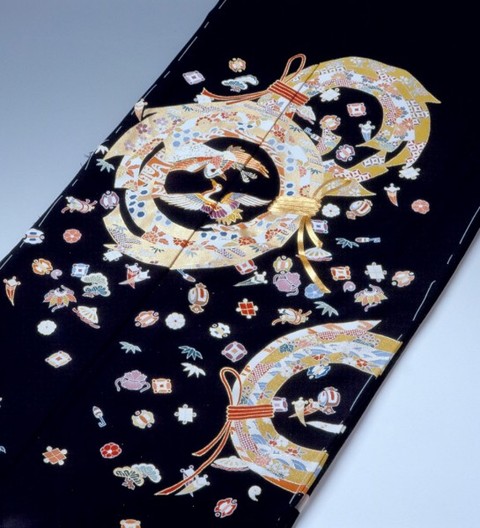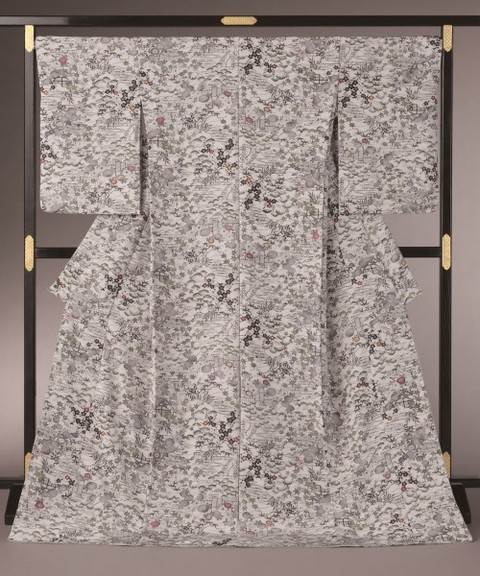
京友禅
染色技法は8世紀から伝わり、手描友禅は江戸時代に京都の絵師宮崎友禅斉によって確立されたと伝えられています。扇絵師として人気の高かった宮崎友禅斉が、自分の画風をデザインに取り入れ、模様染めの分野に生かしたことで「友禅染め」が生まれました。
色数が多く絵画調の模様を着物に染める友禅染は、町人文化の栄えた江戸時代の中期に盛んに行われるようになりました。明治時代には、型紙によって友禅模様を染める「写し友禅染め」が開発されました。

京小紋
京小紋の始まりは、基本となる型紙が作られた1200年前に遡ります。室町時代に起きた応仁の乱の後、様々な絹織物が生産されると辻ヶ花染や茶屋染が発達し、京都の堀川を中心として染色の職人町が出来ました。
上杉謙信の紋付小紋帷子(もんつきこもんかたびら)や徳川家康の小花紋小紋染胴服(こばなもんこもんぞめどうふく)等は、小紋の技法を駆使して作られています。この頃に、防染糊を置いたあと引染めする小紋の技術が完成されました。

Kyoto Yuzen Dyeing
Although dyeing techniques had existed since the 8th century, it is said that the yuzen technique of painting dye directly onto cloth was established by Miyazaki Yuzensai, a popular fan painter living in Kyoto toward the end of the 17th century. He introduced his own style of painting as a way of rendering pattern and this led to the birth of this handpainted dyeing technique. A multicolored yuzen was used to apply painterly designs to kimono cloths and grew in stature from the middle of the 18th century as merchant culture flourished. In the Meiji period (1868-1912), utsushi yuzen was developed using stencils to create these distinctive designs.
It would not be an exaggeration to say that Kyoto yuzen, with its rich variety of motifs drawn from nature has become synonymous with the Japanese kimono. And, despite an extensive use of color, there is still within the noble tenor of the designs a special aesthetic quality that has been nurtured over the thousand years of the history of Kyoto. There are now 253 government recognized Master Craftsmen among the 13,695 employed by the 2,280 firms sustaining this elegant craft.

Kyoto Fine-Pattern Dyeing
Kyoto fine-pattern dyeing dates back more than 1,200 years, when the all-essential stencil papers were first made. After the Onin War which occurred during the Muramachi period (1333-1568), a number of different kinds of silk cloths were produced. This led to the development of two forms of stencil dyeing, tsujigahana and chaya-zome around the area of Horikawa in Kyoto and became a dyeing center. Fine-pattern dyeing can be found on a number of important garments includin
g a coat belonging to Uesugi Kenshin bearing his crest, and on a waistcoat worn by Tokugawa Ieyasu also bearing his crest. It was about this time that rice-paste resist techniques were perfected.
This form of fine-pattern dyeing was a method of stencil dyeing small patterns in a single color on such garments as a kamishimo, the ceremonial robe worn by the warrior classes. These days just as in the past fine patterns are still being dyed using stencil papers but much bolder western florals have now been added to its repertoire. Cloth is mainly produced for kimono and coats these days, and 121 firms employing 605 staff of which 37 are government recognized Master Craftsmen, still maintain the traditional techniques of this ancient craft.